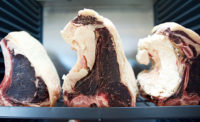 Dry-cured hams, popularly known as country hams, are a regional delicacy enjoyed in the southeastern United States. Country hams are shelf-stable meat products cured by rubbing salt on the surface, which will penetrate the ham for 50 days or more, depending on weight.
Dry-cured hams, popularly known as country hams, are a regional delicacy enjoyed in the southeastern United States. Country hams are shelf-stable meat products cured by rubbing salt on the surface, which will penetrate the ham for 50 days or more, depending on weight.
Cured hams are aged at warm temperatures (75°F or higher) for several months to develop their characteristic flavor and aroma through the breakdown of proteins and fats. The majority of country hams are aged for more than six months.
Ham curers, for generations, used the rule of thumb that salt will penetrate a ham at about an inch per week. Ziegler and Miller (1938, Pennsylvania Agricultural Experiment Station Report, Bulletin 355) confirmed the hypothesis; however, these authors analyzed salt penetration from top to bottom of the hams vertically.
Researchers at the University of Kentucky took a different approach and analyzed salt penetration in the major ham muscles. All exposed surfaces of the green hams (24 lbs. each; n = 8) were rubbed with a typical dry-cure mixture (80% salt, 18% brown sugar, 1% red pepper, and 1% black pepper) at approximately 10% of the green weight and allowed to cure to 60 days at 4°C. The percentage of salt from the outer surface to 1 inch (depth 0), 1-2 inches (depth 1), and 2-3 inches (depth 2) was analyzed in the Biceps femoris (BF), Semitendinosus (ST), and the Semimembranosus (SM) muscles on days 21, 30, 45, and 60 (n = 2 hams per day).
The SM had the highest percentage of salt at all depths when compared to the other muscles throughout the curing period, which was expected, as the SM is not covered by skin. The depth 2 (deepest area analyzed) had the lowest percentage of salt in all three muscles throughout the 60 day curing period.
According to the USDA, dry cured hams must contain at least 4% salt to be labeled country ham. The SM achieved this requirement at all depths examined by 30 days of curing, and the ST by 60 days; however, only depth 0 achieved this prerequisite by Day 60 for BF. The muscles BF and ST are covered by skin and subcutaneous fat, and therefore, are logically anticipated to have slow salt-penetration rates.
Typically cured hams will be subjected to salt equalization by moving to a warmer room (approximately 50°F) for 15 to 30 days to allow for the salt to migrate throughout the ham before aging at even warmer temperatures.
It could be assumed that all depths within each muscle inside a ham will achieve the required 4% salt during salt equalization. These results indicated that the rate of salt penetration in dry-cured hams is muscle-specific.
For more information on this research, contact Gregg Rentfrow at gkrent2@uky.eduor (859) 257-7550.



Report Abusive Comment